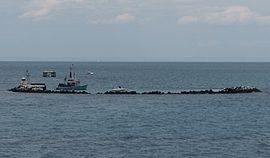Port Phillip Heads Marine National Park
| Port Phillip Heads Marine National Park Victoria | |
|---|---|
 Pope's Eye fort located within the marine park. | |
| Nearest town or city | Melbourne |
| Coordinates | 38°16′45″S 144°42′55″E / 38.27917°S 144.71528°E |
| Established | 16 November 2002[1] |
| Area | 35.8 km2 (13.8 sq mi)[1] |
| Managing authorities | Parks Victoria |
| Website | Port Phillip Heads Marine National Park |
| See also | Protected areas of Victoria |
The Port Phillip Heads Marine National Park is a
Location and features
This section needs additional citations for verification. (August 2014) |
The marine national park was created on 16 November 2002 and represents an expansion of, as well as giving stronger protection to, areas previously collectively termed the Harold Holt Marine Reserve system. The park is assigned the IUCN's Category II of the United Nations’ List of National Parks and Protected Areas, showing that the park is managed by Parks Victoria primarily for ecosystem protection and recreation.[1][2]
The six sites in the marine national park are Mud Islands, Point Lonsdale, Point Nepean, Pope's Eye, Portsea Hole, and Swan Bay.
The closest towns to the areas include
Habitats protected by the marine national park include
Additional and overlapping protection[
Threats
A proposal to dredge mechanically the entrance to Port Phillip and sections of the main shipping channel to the Port of Melbourne, in order to facilitate access by larger ships, has the potential to cause extensive turbidity, the release of toxic sediments and mechanical damage to reefs, threatening benthic communities as well as affecting economic activities in the bay such as diving businesses and fishing.
See also
References
- ^ )
- ^ "Port Phillip Heads Marine National Park" (PDF). Parks Victoria (PDF). Government of Victoria. December 2003. Retrieved 13 March 2011.
External links
- "Port Phillip Heads Marine National Park". Parks Victoria. Government of Victoria.

